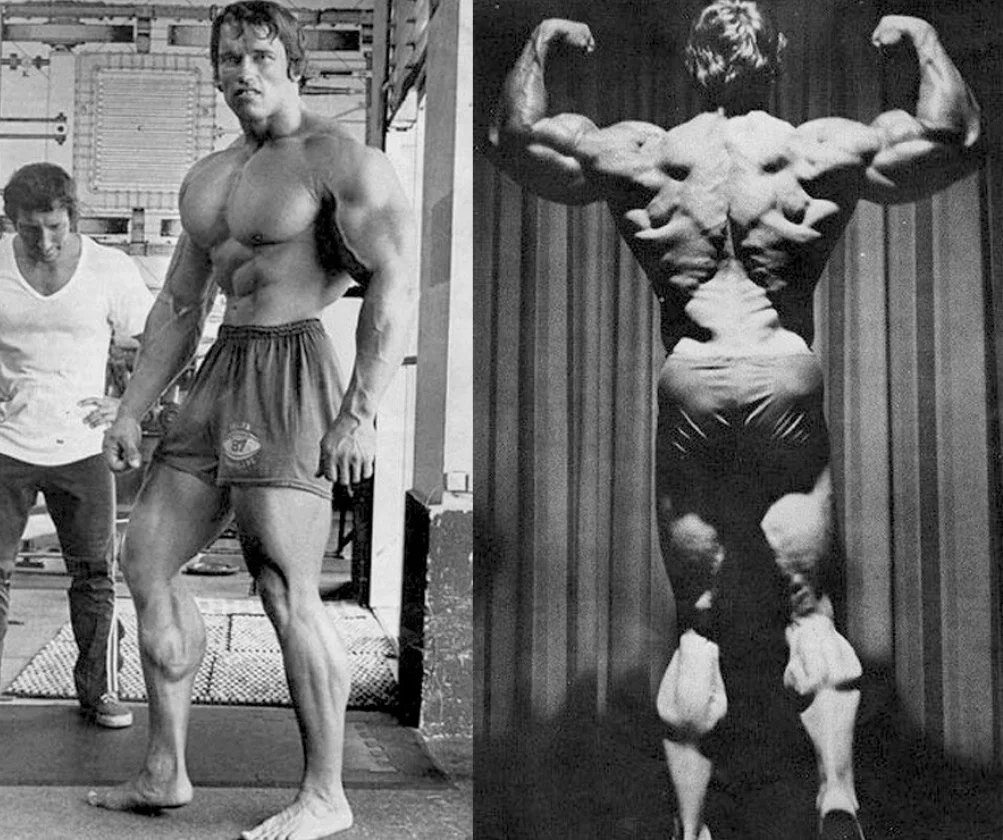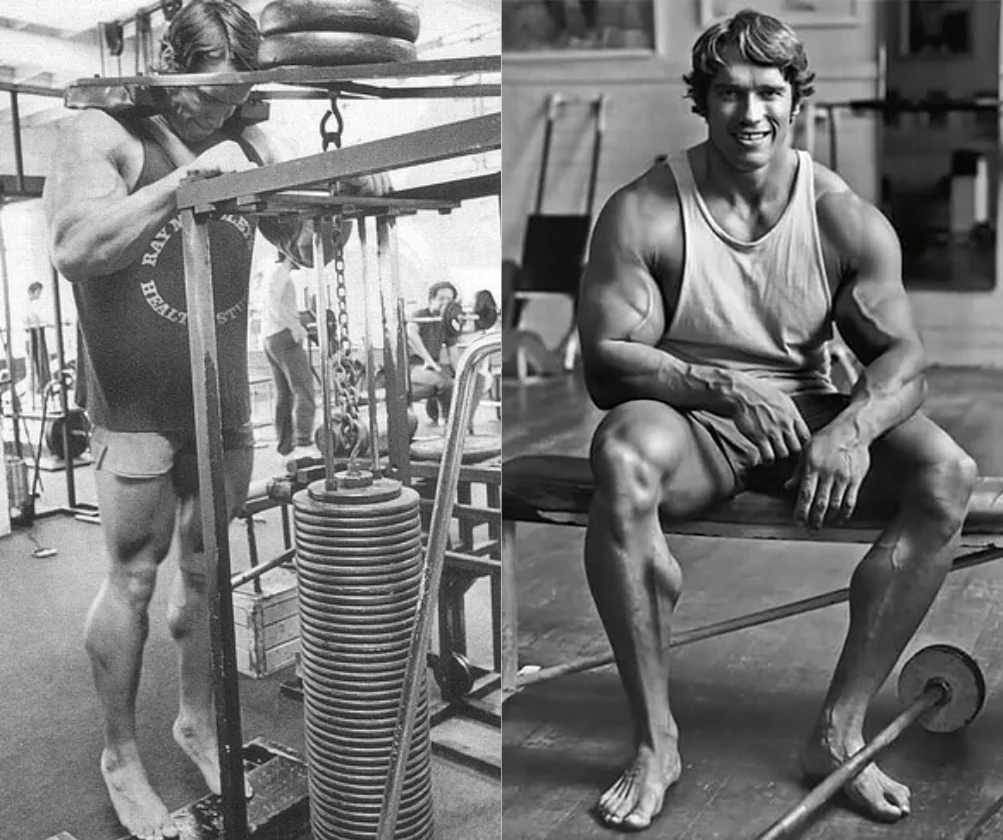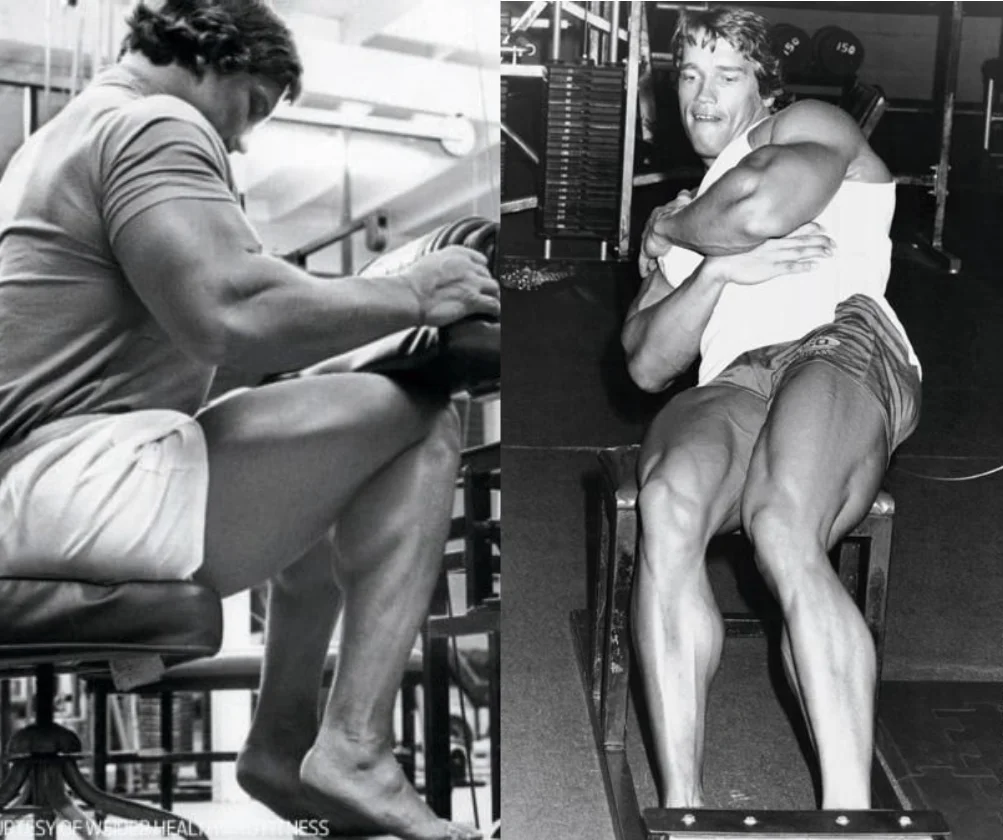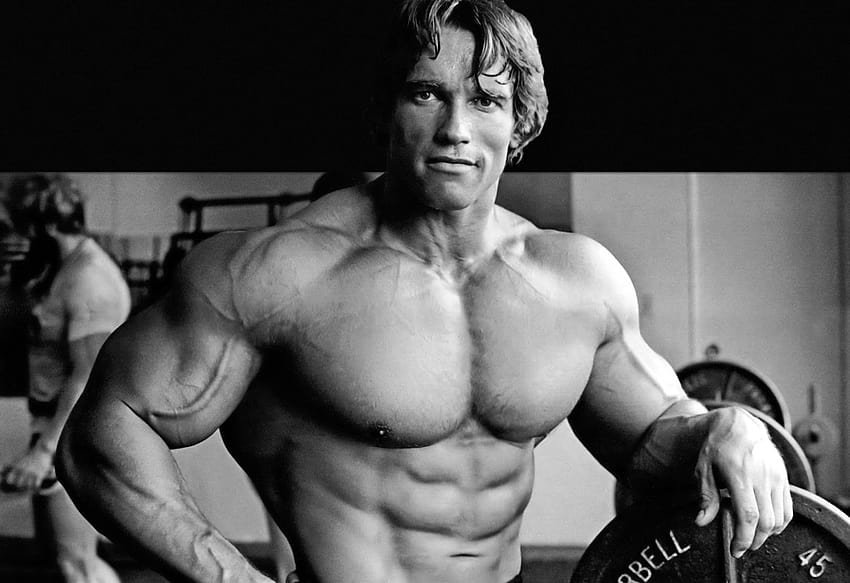Embarking on a journey to transform your calves from mere afterthoughts to attention-demanding powerhouses?
Welcome to the realm of old-school calf workouts – a sanctuary of proven exercises and time-tested programs designed to turn your little calves into massive, awe-inspiring cows.
In the vast landscape of bodybuilding, the calves stand out as a formidable challenge, notorious for their reluctance to grow.
The prevailing belief that genetics plays an insurmountable role in calf development has discouraged many aspiring fitness enthusiasts.
However, a glimpse into the golden age of bodybuilding reveals a different story. The champions of that era didn’t succumb to the myth of stubborn calves instead, they embraced the philosophy of hard and consistent work.
In the pursuit of well-developed calves, the luminaries of the golden age didn’t shy away from the grind or fret about overtraining.
They simply dedicated themselves to rigorous calf workouts, and the result was clear – robust, attention-grabbing lower legs became a hallmark of their physiques.
This article is your guide to breaking free from the misconception that great calves are an elusive feat.
Say goodbye to hiding your lower legs under long sweatpants it’s time to embark on a journey that unveils the secrets of the best old-school calf workouts. Let’s build lower legs you can be genuinely proud of.
Understanding the Anatomy of Your Calves
For such a seemingly small muscle group, the calves wield surprising complexity.
Comprising two primary muscles, the gastrocnemius and soleus, calf development requires a diverse range of exercises.
A deeper insight into their anatomy not only sheds light on their intricacies but also guides us in selecting the most effective workouts.
Calf Anatomy 101: Unveiling the Muscular Duo
Gastrocnemius
As the larger of the two calf muscles, the gastrocnemius boasts a unique biarticular nature, crossing both the ankle and knee joints.
Responsible for ankle plantar flexion (toe pointing) and aiding in knee flexion, it synergizes with the hamstrings.
The common insertion point for both muscles is the Achilles tendon, anchoring onto the heel bone or calcaneus.
Soleus
Nestled beneath the gastrocnemius, the soleus, though smaller, plays a vital role. It solely crosses the ankle joint, contributing to plantar flexion.
Despite sharing the Achilles tendon insertion, the unique origin points of these muscles allow for targeted emphasis during workouts.
Understanding the dynamics of these muscles unveils the key to effective calf training – manipulating ankle and knee positions to isolate and develop each muscle. As we delve into the best old-school calf workouts, this knowledge becomes paramount.
The Best Old-School Calf Workouts: Unleashing the Classics

Embark on a journey inspired by the legends of the golden era with three timeless calf-building workouts:
Golden Gastrocnemius Blast: Emulate the routines of iconic bodybuilders by incorporating standing calf raises.
Focus on ankle plantar flexion to target the gastrocnemius. Feel the burn as you sculpt this prominent calf muscle.
Soleus Special
Take a cue from classic calf development by engaging in seated calf raises. With a bent knee position, activate the soleus for a comprehensive lower leg workout.
Witness the transformation of your lower, smaller calf muscle.
Dynamic Duo Delight
Combine standing and seated calf raises to achieve a harmonious blend of gastrocnemius and soleus activation.
Mimicking the strategies of golden-era bodybuilders, this workout ensures a well-rounded approach to calf development.
Before embarking on these classic routines, ensure a proper warm-up routine.
Dedicate a few minutes to easy cardio, dynamic stretching, and light sets of each exercise to prepare your muscles and safeguard against injury.
These old-school gems promise to sculpt your calves into powerful, attention-demanding assets.
Arnold Schwarzenegger’s Calf Transformation: A Tribute to Old-School Excellence

In the early days of Arnold Schwarzenegger’s bodybuilding journey, he faced a formidable challenge – small calves that threatened to overshadow his impressive physique.
Determined to turn this weakness into strength, Arnold Schwarzenegger devised a calf workout routine that became instrumental in his transformation.
Inspired by the Austrian Oak himself, this old-school calf workout promises to shock your calves into new growth, just as it did for the legendary bodybuilder.
The Workout Routine: 2-3 Times a Week for Calf Mastery
Donkey Calf Raises (5 Sets of 15-20 Reps):
Channeling the spirit of Arnold Schwarzenegger’s relentless dedication, start your calf workout with donkey calf raises.
This exercise, where you position yourself on a specialized donkey calf raise machine or with a partner providing resistance, targets the calves intensely. Aim for higher reps to engage the muscles effectively.
Standing Calf Raises (5 Sets of 10-15 Reps):

Stand tall and emulate Arnold Schwarzenegger’s iconic pose as you move into standing calf raises. This classic exercise focuses on ankle plantar flexion, emphasizing the gastrocnemius muscle.
Execute controlled movements to maximize the impact on your calves.
Seated Calf Raises (5 Sets of 10-15 Reps):
Sit down and shift the emphasis to the soleus with seated calf raises. By bending your knees, you activate the lower calf muscle, contributing to a well-rounded lower leg development.
Follow Arnold Schwarzenegger’s footsteps as you push through each set, feeling the burn that signifies growth.
Arnold Schwarzenegger’s dedication to calf training went beyond the gym. To address his initial embarrassment, he even went as far as cutting the bottoms off his workout pants to showcase his calves consistently.
This workout is not just a routine it’s a tribute to the mindset that turned a perceived weakness into a symbol of strength.
Incorporate this routine 2-3 times a week, and let Arnold Schwarzenegger’s legacy inspire your journey to awe-inspiring calf development.

1.1 Donkey Calf Raises: Unleashing the Terminator’s Favorite
An integral part of Arnold Schwarzenegger’s legendary calf routine, Donkey Calf Raises stands out as a unique and effective old-school exercise. Despite raising a few eyebrows at the gym, the results speak for themselves.
This exercise takes your ankles and calves through a significant range of motion, delivering a deep stretch and pump that accelerates calf growth.
How to Do It:
- Stand with the balls of your feet on a 4-6″ block, allowing your heels to move freely.
- Keep your legs straight, lean forward, and brace your arms against a bench or dumbbell rack.
- Have your training partner sit astride your hips.
- Lower your heels down as far as possible and then rise on your tiptoes. Repeat for the prescribed number of reps.
Tips:
- Avoid letting your partner sit on your lower back to prevent potential injury.
- For added resistance, perform this exercise on your own by wearing a chin/dip belt.
- Unlock the power of Donkey Calf Raises – the exercise that fueled the growth of the Terminator’s calves.
1.2 Standing Calf Raises: Lifting the Legacy
An exercise favored by Arnold Schwarzenegger himself, Standing Calf Raises is a classic mass-building cornerstone for calf development.
Don’t shy away from challenging weights your calf muscles are robust and can handle the intensity. Embrace this exercise to sculpt calves that command attention.
How to Do It:
- Adjust the height of the machine and step onto the footrest, ensuring the balls of your feet are on the edge.
- Place your shoulders under the pads and stand up, bracing your abs and locking your knees.
- Rise onto your tiptoes and lower your heels as far down as possible.
- Pause for a second at the top and bottom of each rep to maximize muscle tension.
Tips:
- Maintain core bracing for spinal stability, especially with heavyweights.
- Avoid bouncing at the bottom of your reps to prevent the risk of a torn Achilles tendon.
- Embrace the power of Standing Calf Raises – a classic exercise that once saw Arnie working up to sets with an impressive 1000 lbs.
1.3 Seated Calf Raises: The Soleus Finisher
Completing the trifecta, Seated Calf Raises target the soleus, Arnold Schwarzenegger’s secret weapon for a well-rounded calf development.
While not always necessary, Arnold Schwarzenegger often concluded his calf workouts with this exercise, emphasizing the importance of a comprehensive approach.
How to Do It:
- Sit on the calf raise machine with the balls of your feet on the footrest.
- Place your legs under the thigh pads and unrack the weight.
- Push up onto your tiptoes and then lower your heels as far as possible. Continue for the prescribed number of reps.
Tips:
- Ensure the leg pad is across the tops of your knees to avoid discomfort.
- Elevate your calf training with Seated Calf Raises, the exercise that Arnold trusted to finish his legendary calf workouts.
Machine-Free Mastery: Crafting Old-School Calves
In the era when standing and seated calf raise machines were a rarity, champions of bodybuilding sculpted impressive lower legs with sheer determination.
This machine-free calf workout pays homage to those early days, offering an ideal routine for home exercises or those navigating a gym without dedicated calf-raise machines.
All you need is a few free weights to embark on this journey of calf development.
The Workout Routine: Twice Per Week for Timeless Results

For those seeking calf mastery without the confines of machines, engage in this workout twice a week on nonconsecutive days, injecting the spirit of old-school training into your modern fitness routine.
Single Leg Calf Raises (4 Sets of 12-15 Reps):
- Elevate one foot and balance on the other.
- Execute calf raises by lifting the heel as high as possible.
- Feel the burn as you focus on each calf individually, fostering balanced development.
Goose Step (4 Sets of as far as Possible):
- Emulate the iconic goose step, emphasizing a pronounced flexion of the ankle.
- Engage in this dynamic exercise, pushing the limits of your range of motion.
- Stride with purpose, encouraging a unique contraction for calf stimulation.
Ankle Jumps (4 Sets of 50 Reps):
- Harness the power of explosive movements with ankle jumps.
- Propel yourself off the ground, utilizing the strength of your calves.
- Embrace the challenge of high reps, fostering endurance and definition.
As you navigate this machine-free calf workout, savor the simplicity and effectiveness of these exercises.
Crafted for home workouts or gym environments with limited equipment, this routine invites you to defy the constraints and build timeless calf strength.
Execute this routine on nonconsecutive days, allowing your calves to flourish and embody the essence of old-school bodybuilding.
2.1 Single Leg Calf Raises: Elevating Calves Without Machines
No calf raise machine?
No worries! This exercise proves just as effective, and the best part?
All you need is a step and a dumbbell to embark on this journey of sculpting powerful calves.
How to Do It:
- Stand on a 4-6″ high step, ensuring one foot is centered with the ball on the edge and the heel free to move.
- Cross your ankles and utilize your hands for balance.
- Keep your supporting knee straight and rise onto your tiptoes, then gracefully lower your heel toward the floor.
- Execute the prescribed number of repetitions and switch to the other leg.
Tips:
- Enhance the challenge by holding a dumbbell in one hand, amplifying the resistance and fostering increased calf engagement.
- Transform your home or gym space into a calf-sculpting haven with Single Leg Calf Raises.
A step and a dumbbell are your simple tools for crafting strength and definition in each calf, proving that effective calf workouts can thrive without the need for specialized machines.
2.2 Goose Step: Marching into Unconventional Calf Growth
Goose steps, a classic old-school calf exercise, stand as a testament to unconventional training practices.
This exercise, often unfamiliar to modern fitness enthusiasts, might be unusual, but the results it delivers in calf growth are undeniable.
How to Do It:
- Hold a heavy dumbbell in each hand or rest a barbell on your shoulders.
- Rise onto your tiptoes, then confidently take a walk around your training area without letting your heels touch the floor.
- Continue until you can no longer keep your heels off the ground, signaling the completion of your set.
Tips:
- Ensure a sturdy grip by using wrist straps, preventing grip failure before your calves reach fatigue.
- Embark on the unconventional journey of Goose Step, where the pain meets effectiveness, and your calves grow in ways you never imagined.
2.3 Ankle Jumps: Unleashing Explosive Calf Power
The final act in this old-school calf workout introduces an explosive and athletic exercise inspired by the robust calves of sprinters and jumpers.
Mimicking the dynamic movements of these activities, this exercise promises to amplify calf strength and size.
How to Do It:
- Stand with your feet together, hands by your side.
- Maintain straight knees as much as possible and jump up and down on the spot, propelling yourself off your toes without letting your heels touch down.
- Continue for the prescribed number of reps.
Tips:
- Add a lateral component by jumping from side to side, engaging the lateral aspect of your calves.
- Increase difficulty by hopping on one leg or holding dumbbells in your hands for an added challenge.
- Elevate your calf workout with Ankle Jumps, an exercise that not only builds strength but also mirrors the explosive nature of sprinting and jumping activities.
FAQs
That’s a tricky question to answer, as old-school bodybuilders had varying approaches. Some trained their calves once a week, while others, like Arnold, trained them six times a week!
If your calves aren’t growing, increasing training frequency might help. If you’re currently working your lower legs twice a week without desired results, consider adding another workout.
Absolutely! Many old-school bodybuilders trained their calves barefoot, believing it made their calves work harder without the support of shoes.
Before going shoeless, check with your gym to ensure they permit barefoot training, as some may have concerns related to hygiene or safety.
Certainly! It’s an excellent idea. Train your calves with your legs 1-2 times per week at the gym and supplement with 1-2 home workouts to enhance calf growth. Old-school calf workout #2 is particularly suited for home training.
Genetics plays a role in the size and shape of every muscle, including your calves. If you train hard and eat well but still struggle with calf growth, genetics may be a factor.
While some bodybuilders opt for calf implants, consistent hard work can still lead to noticeable improvements.
According to old-school bodybuilders, your calves, arms, and neck should ideally be around the same size.
If your biceps measure 16″, the goal is for your calves and neck to match. While achieving this exact standard may vary, it serves as a good target for many individuals striving for proportional muscle development.